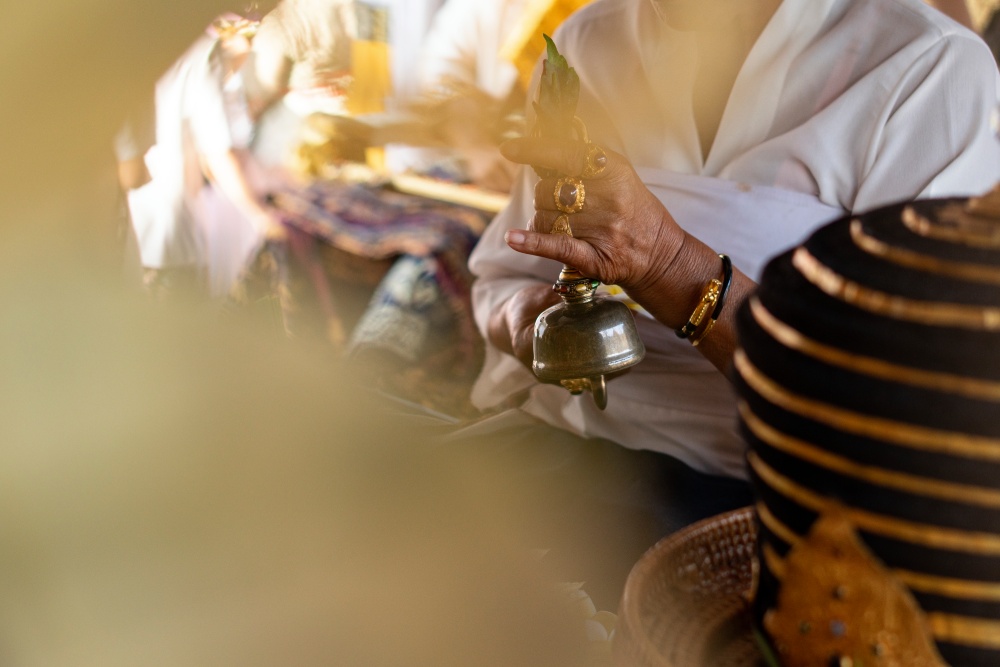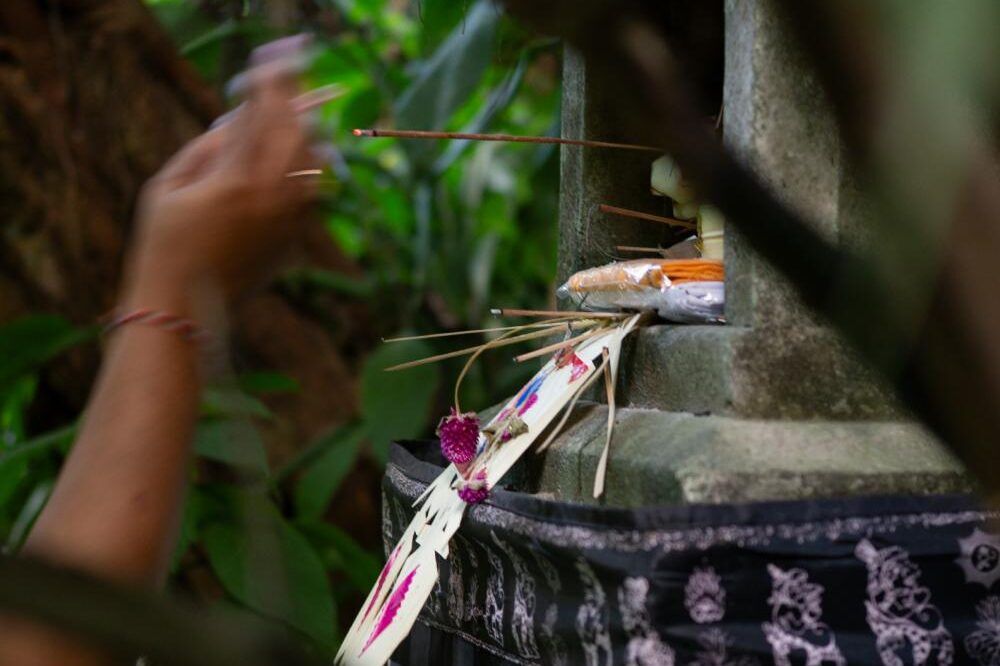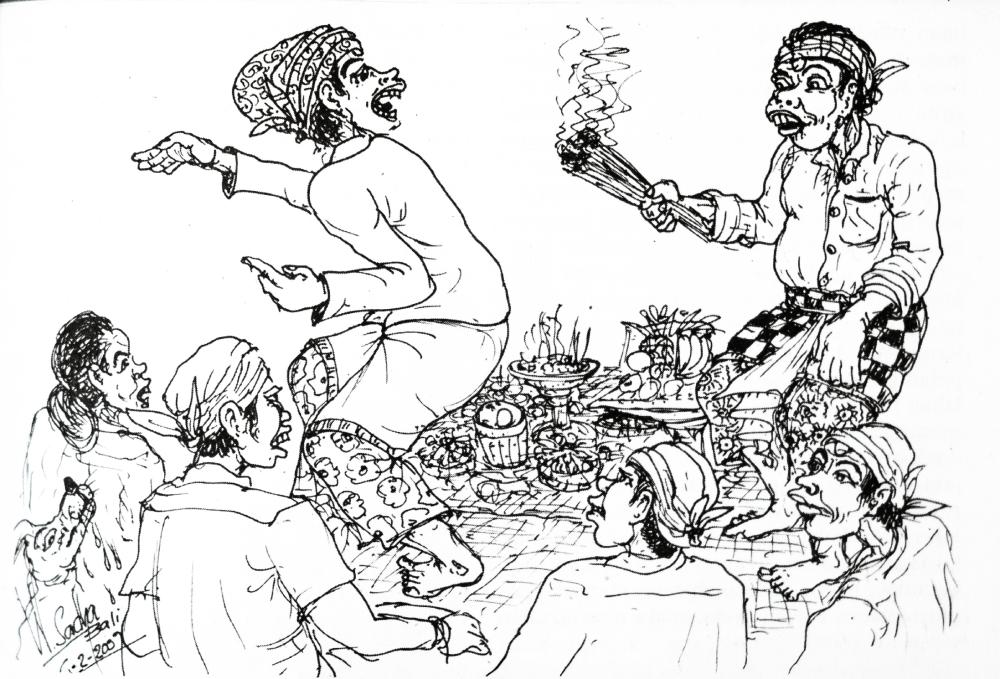
The Balinese have a very special relationship with the gods and the unseen world. To truly understand it, put aside for a while all the fantasies you have heard about the One and Only, and be ready for other fantasies—fantasies that, for the Balinese, have the allure of reality.
The Hindu Gods
In their “system”—which, nota bene, is not fully structured as such—you first have the gods, the Dewa. “Out there,” they occupy definite places and positions: they sit in the directions of the compass, and on the mountains, that, according to legend, were brought to Bali in the times of yore from chunks of Semeru Mountain in Java, which itself was imported from India.
Their peculiarity? Unlike the much more present Balinese gods, these Hindu deities, except for Durga, an Indianised local goddess—never comes down. No one has ever heard of Brahma, Iswara, or Ganesha descending to possess a temple priest in trance during a festival. When a Balinese fell into a Wisnu-invoked trance during a ceremony at Garuda Wisnu Kencana, it was taken as a bad joke.
The gods above are the Hindu gods. Their job is to organise the world, to give sense to reality. And they indeed become reality in myth—all of Indian origin. It is these gods and goddesses who are now presented to young school children as the truth of Hinduism. A well-organised truth: the gods are Dewa—from Dew, meaning “ray of the sun” in Sanskrit. The sun itself is Bhatara Surya. The sum of all these rays is said to be Sang Hyang Widhi Wasa, who is also Siwa or Acintya—translated as “The Divine Ruler of the Universe.”
In other words, a monotheistic concept of divinity has been squeezed into a system that, until 100 years ago, had no need for such a narrow reduction of its complexity. But there were good reasons for this. Nowadays, if you ask an educated Balinese to define the god they are talking about, the answer will almost always be: “It is a manifestation of the Supreme God.” They may even add: “Its main manifestations are three: Brahma the Creator, Wisnu the Preserver, and Siwa the Destroyer.”
This explanation conveniently closes the door to the skepticism of his Muslim friend and the missionary enthusiasm of his Christian neighbor—who cannot pull such a rationalised system out of their pockets.
The Inhabitants of the “Intemporal” Niskala

The Hindu gods are up there, far away, on the mountains and beyond. They provide a cosmogony, an explanation for the world.
Are they important to the Balinese, apart from being official? Yes and no.
Outside of the twice-born high priests (sulinggih), most Balinese do not focus their attention on these distant Hindu gods who explain, and hence settle, everything. Their real attention is given to the big disorder rumbling below—here, there, everywhere—in what is called niskala, literally the “atemporal” world. A world that, for the Balinese, is no less present—perhaps even more present—than the real one.
This niskala world is filled with niskala “forces”. Some of them are easy to guess, considering the amount of time spent dealing with them in rituals. The ancestors, for example—in their various names and stages of evolution: Pitra, Pitara, and finally Batara. Sometimes they are in residence up above the mountains; other times, they come down to visit their sentana (descendants) during temple festivals, or they are in transition—on the way there, on the way back.
You had better not forget your duties—and your offerings—at any of these moments. Or else!
Things get more complicated when the dead are not yet full ancestors—not yet fully purified. Still on the way to their final abode above the mountain, they go through various post-death and post-cremation ceremonies. Forgetting an offering can be dangerous. Maybe you won’t notice anything at first. But later, if you suddenly fall ill and seek the cause, a balian (spiritual healer) may tell you that your dead grandfather is burning in a fire—because you forgot an offering. And so, he is sending you an illness as a reminder.
Yet, ancestors are not too complicated. With the right offerings, they can be dealt with. The problem is that they are not the only ones around.
The Local Gods and the Nameless Forces
Beyond the Hindu gods and the ancestors, there are the local gods—often tied to specific places, with names like Ratu Tangkub Langit, Ratu Ketut Petung, or Ratu Ngurah Pangadangan. These are not Indian gods. They simply inhabit a place.
If you happen to pass through their area, they expect recognition. A small offering will do.
But next to these named gods, whom you can acknowledge and deal with, there are others, without names, invisible but ever-present. If you misbehave in their vicinity, say, by kissing your girlfriend in the wrong place, you might regret it.
And these are only part of the niskala. There are also the demonic forces—the rencang (companions of the gods), the widadara-widadari, gendrowa, and countless other beings, from the simply mischievous gamang to the outright dangerous bhuta kala.
This is why temple festivals, rituals, and offerings are not just symbolic. They are meant to keep things in balance. You don’t make offerings to Rangda the Witch because you like her—you do it because, if you don’t, she will let loose her sisia (disciples) to spread illness across the land.
Nyungsung Betara: Bringing the Niskala Down

For this reason, the Balinese don’t simply address the gods up there. More important is welcoming them down here. To call them down, inviting them to dwell in the human world.
The gods and spirits don’t just hover in the niskala—they descend. They take form in trees (which is why some are wrapped in checkered or yellow cloth), in sacred objects, and in people.
And then, there are people who become living vessels for the divine. The mangku (priest) is literally “the lap in which the divine sits.” The dasaran is “the grounding,” the tapakan “the receiving palm.”
Some possessions are structured, occurring during temple festivals. The local deities, often the ancestors, descend on schedule, invited through prayers and trance rituals. But other times, a god shows up unexpectedly.
What does it mean, this flurry of jero falling into trances all over the place?
To those who understand the ways of the gods, it is a sign. Something is shifting in the niskala. The unseen world is restless. And when that happens—changes are coming.
This is the implicit message, with a related question. When will these changes become visible in politics— where there are always too few dewa, and too many gamang and bhuta kala.









